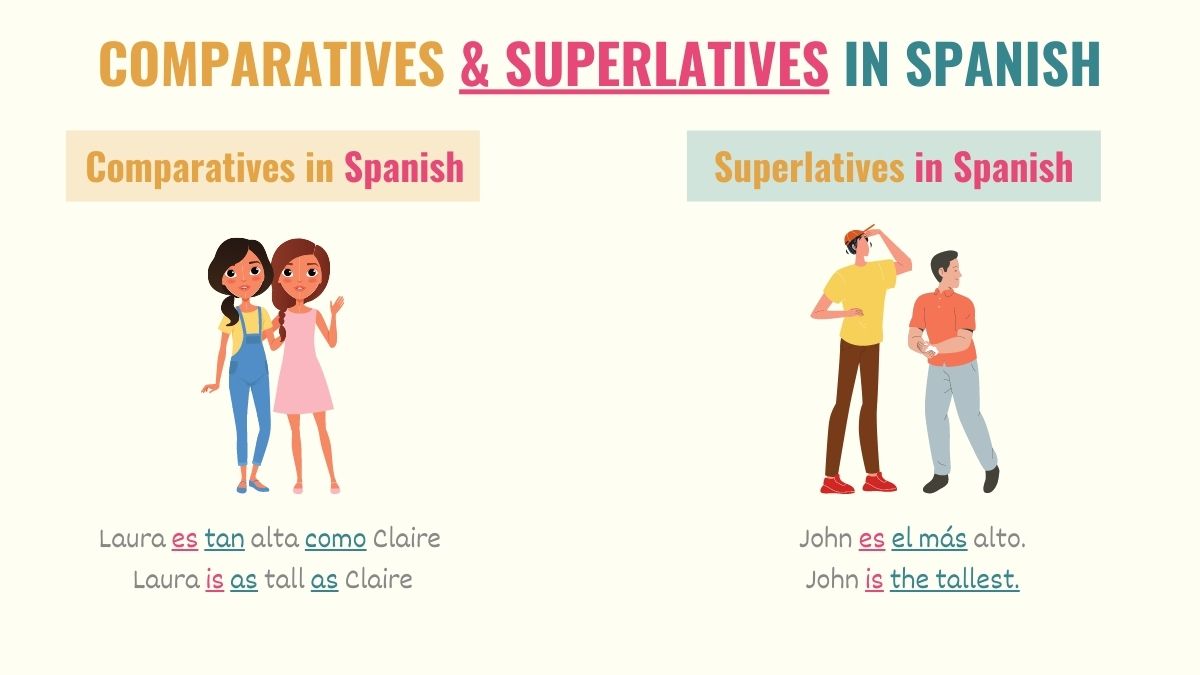One of the most common ways to describe someone or something in Spanish is to compare it against something similar. If you think about it, people compare things against each other on a daily basis. As a result, you should take the time to master Spanish superlatives and comparatives.
Comparisons and superlative adjectives are an important part of learning Spanish. For that reason, in this guide, you’ll find essential information about what these structures are, when to use them and how to form them. Here is a quick overview of the topics we’ll cover:
- What are Spanish comparatives, and when to use them?
- Spanish Superlatives: definition, types, and uses
- Key Points
You’ll know how and when to use both comparatives and superlatives structures in Spanish by the end of it.
What Are Spanish Comparatives and When to Use Them?
Comparatives in Spanish are structures that allow people to compare and contrast someone or something’s characteristics against others. In other words, comparatives express how similar or different these things are from each other.
For instance:
Mi perro es tan lindo como el tuyo.
My dog is as cute as yours.
Ruth es más alta que Ben.
Ruth is taller than Ben.
If you check these previous examples, you’ll notice that we’re comparing and contrasting characteristics that the two subjects share. In example #1, the characteristic is “cute”, and we’ve determined that both dogs are equally cute. However, if you compare Ruth against Ben, you’ll realize that they don’t share the same height.
As you can see from these examples, comparatives in Spanish are classified into:
- Comparisons of equality express that things being compared have the same characteristics.
- Comparisons of inequality imply that the objects being compared don’t have the same attributes.
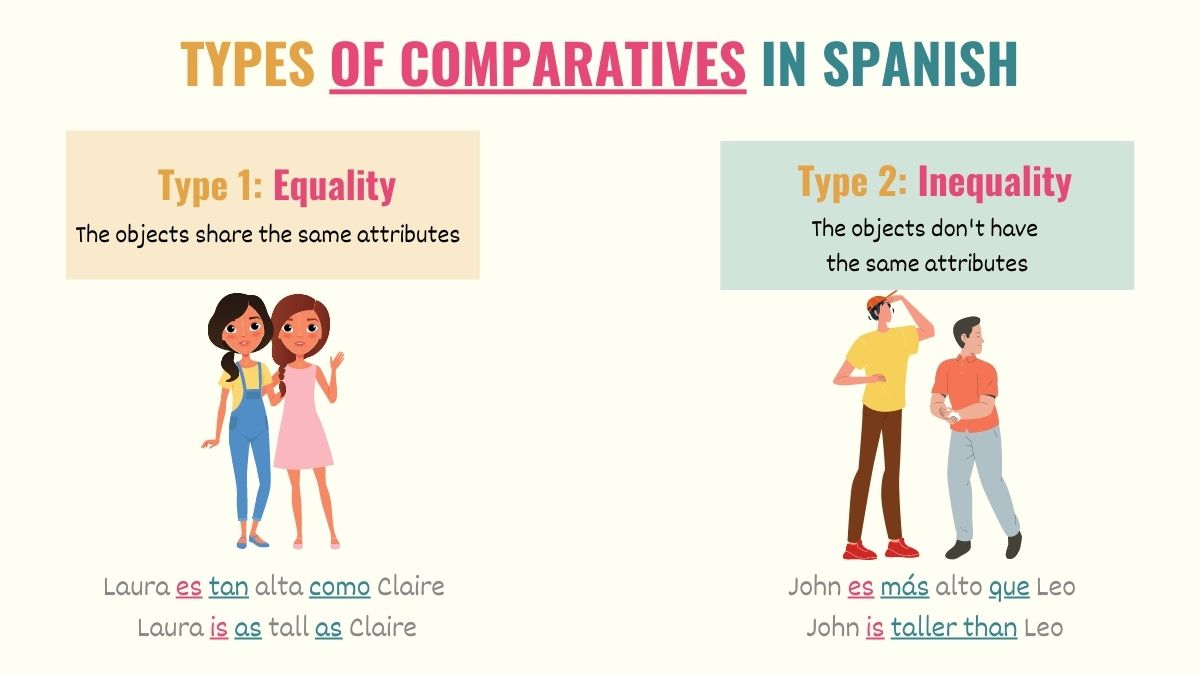
Many new learners think that Spanish comparatives are only limited to describing objects and people. However, you can also make comparisons between actions and amounts. Check these examples:
Elvira come más rápido que Leo.
Elvira eats faster than Leo.
Esta computadora cuesta menos de $20,000 pesos.
This computer costs less than $20,000 pesos.
Forming Spanish comparatives
To build regular comparatives in Spanish, you must always use certain elements. The formulas you need to form comparatives will vary depending on whether you’re making a comparison of equality or inequality.
Comparisons of equality in Spanish
As mentioned before, you use comparisons of equality when you’re expressing that two subjects have the same characteristics or perform an action in the same way. To form this type of Spanish comparative, you should use one of the following comparative structures:
… tan + [adjective/adverb] + como…
Or:
… igual + de + [adjective/adverb] + que…
Both of these structures can be translated as “equally” or “as [adjective/adverb] as”. As a rule of thumb, every time that you’re comparing people or things (or nouns for grammar freaks), you must use the Spanish verb ‘ser’.
Here are some examples of how to build comparatives sentences in Spanish:
[Subject 1] + [‘ser’ conjugated] + tan + [adj / adv] + como + [subject 2]
Clive no es tan inteligente como ustedes.
Clive is not as intelligent as you guys.
Tus flores son tan bonitas como las mías.
Your flowers are as pretty as mine.
Or:
[Subject 1] + [‘ser’ conjugated] + igual de + [adj/adv] + que + (subject 2)
Tu carro es igual de rápido que el mío.
Your car is as fast as mine.
Leslie es igual de amable que su mamá.
Leslie is as nice as her mom.
Take Note: Tan always precedes an adjective or adverbs. However, this word will change to tanto if a noun immediately follows it. This type of structure compares the quantity of a noun against another. ‘Tanto’ agrees in gender and number with the noun.
Tengo tanto dinero como tú.
I have as much money as you.
Oliver no come tantos tacos como Mateo.
Oliver doesn’t eat as many tacos as Mateo.
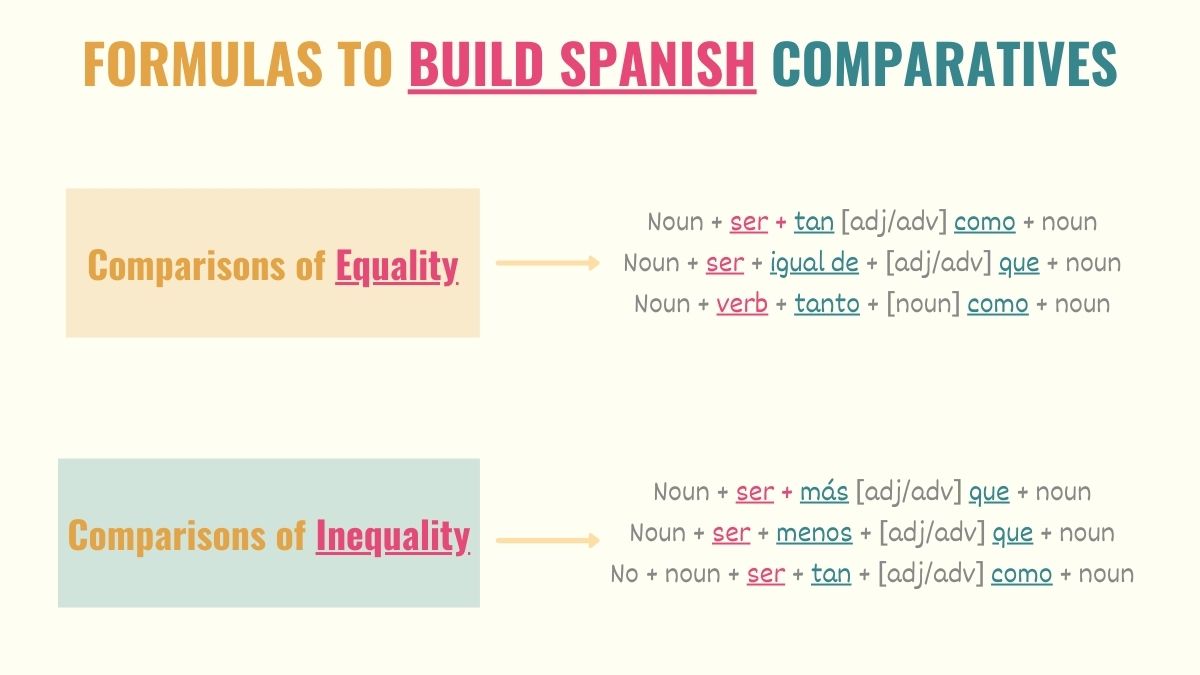
Comparing actions
On the other hand, if you want to compare how two people perform an action, you’ll change ‘ser’ for any verb you need. Aside from this, the structure remains the same:
[Subject 1] + [verb conjugated] + [comparative structure] + [subject 2]
Ellie corre igual de lento que tú.
Ellie runs as slow as you.
Sally habla tan rápido como Tobey.
Sally speaks as fast as Tobey.
Mi mamá cocina tan rico como mi abuela.
My mom’s cooking is as delicious as my grandma’s.
If you want to take your Spanish to the next level, there is also another structure that you can use when comparing actions. In this case, you won’t need to use adjectives or adverbs because the comparison is only focused on the activity being done rather than how it was performed.
[Subject 1] + [verb conjugated] + tanto como + [subject 2]
El camión se tarda tanto como el tren
The truck takes as long to arrive as the train.
Tu hermano no come tanto como el mío.
Your brother doesn’t eat as much as mine.
Te quiero tanto como tú a mí.
I love you as much as you love me.
Comparatives of inequality
As established at the beginning of this guide to comparatives in Spanish, comparisons of inequality are used to explain that two subjects don’t have the same level of a particular attribute. In fact, comparisons of inequality indicate that an object has more or less of a given characteristic than the other.
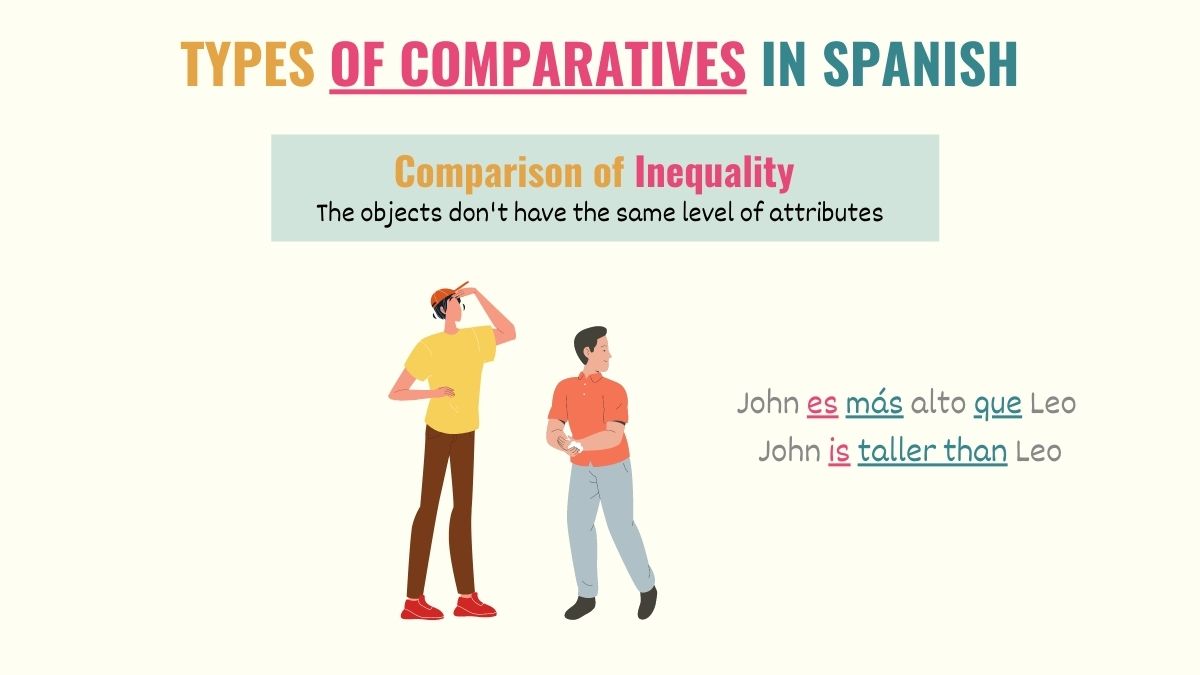
The formulas to build comparatives of inequality in Spanish are:
… más + [adjective/adverb] + que…
Or:
… menos + [adjective/adverb] + que…
These structures are translated as more than and less than, respectively. As you already know, you can use comparatives in Spanish to contrast people, things, and activities. Let’s start with some simple examples:
[Subject 1] + [‘ser’ conjugated] + más/menos + [adj/adv] + que + [subject 2]
Lucía era más inteligente que Paco.
Lucia was more intelligent than Paco.
Mi celular es menos resistente que el tuyo.
My phone is less resistant than yours.
La pizza es más cara que la pasta.
The pizza is more expensive than the pasta.
If you pay attention to these examples, you’ll notice that they express that one of the subjects has a higher or lower degree of the characteristic described. For instance, in example #1 that attribute is intelligence, and we know that Lucía had a higher level of that attribute than Paco.
Take Note: Depending on the adjective you use, the English translation for comparatives of inequality could be translated as more than, or you’ll simply add the ‘er’ ending to the adjective.
Chuck es más alto que Tony.
Chuck is taller than Tony.
Comparing Actions or Activities
Remember that if you’re describing activities, you’ll need to use verbs other than ‘ser’. Additionally, in some cases, the adverb might not be necessary since you may not want to provide extra information on how the action was performed.
[Subject 1] + [verb conjugated] + más/menos + (adverb) + que + [subject 2]
Zoe preparó su maleta más rápido que todos.
Zoe prepared her bag faster than everyone else.
Estos audífonos cuestan menos que los tuyos.
These earphones cost less than yours.
Irregular comparatives
When it comes to inequality comparatives, some adjectives cannot follow the same pattern we’ve learned so far. These are irregular comparatives that you need to memorize. Luckily, there are just 4 of them, and you’ll only use them when building structures with ‘más que’.
The four irregular comparative forms in Spanish are:
| Spanish Adjective / Adverb | Spanish Comparative | English |
|---|---|---|
| Bien | Mejor | Better |
| Mal | Peor | Worse |
| Grande (age) | Mayor | Older |
| Pequeño (age) | Menor | Younger |
Incorrect
Está galleta sabe más mal que la anterior.
This cookie tastes worse than the previous one.
Correct
Está galleta sabe peor que la anterior.
This cookie tastes worse than the previous one.
Take Note: Even though it’s grammatically incorrect, Spanish speakers use the adjectives grande and pequeño with the structure ‘más qué’ in informal conversations.
Spanish Superlatives: Definition, Types and Uses
Spanish superlatives are closely related to comparative sentences since they describe the level of an attribute that a person, activity, or thing has. However, Spanish superlatives are words or structures that help you express that a subject is at the top or at the bottom of a group.
In simple words, you use superlatives in Spanish to:
- Express that a subject inside a group has outstanding characteristics that differentiate him from his peers.
- Emphasize that a subject has the highest level of a certain quality.
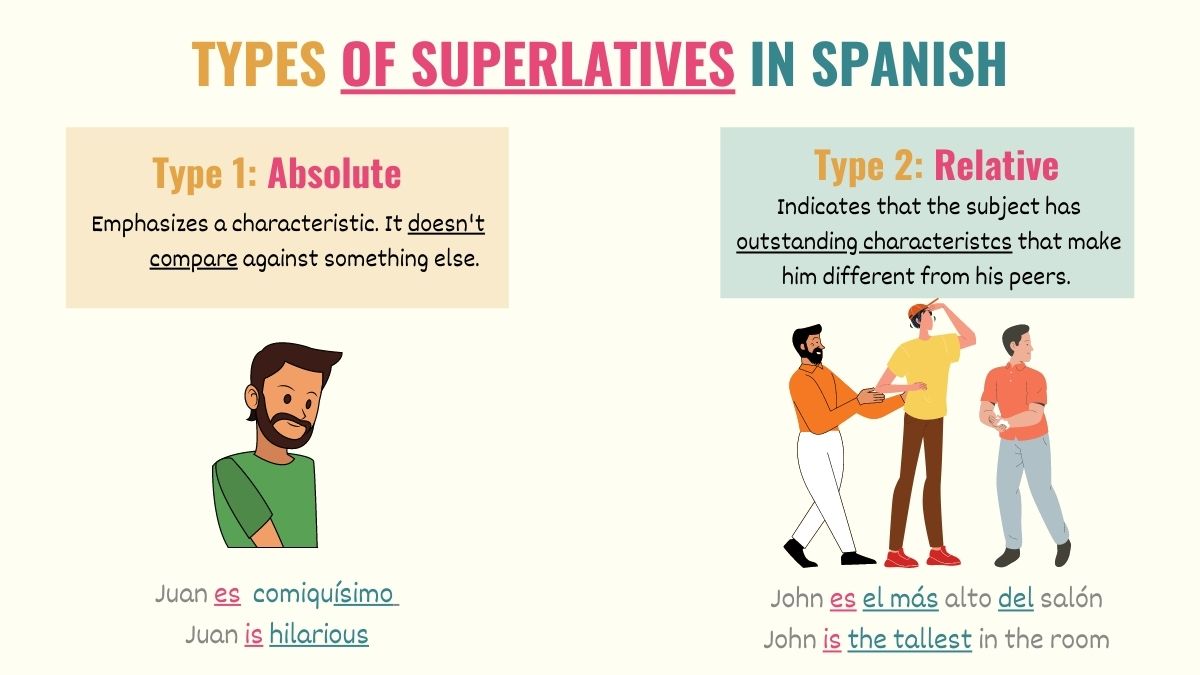
Check these sentences:
Molly habla rapidísimo.
Molly speaks super fast.
Antonio es el más guapo del salón.
Antonio is the most handsome in the room.
El chico nuevo es buenísima onda.
The new guy is very cool.
Compare example #2 against instance #3. In example #2, Antonio is being compared to the other men inside of that room, and he turns out to be the most handsome one. However, in example #3, the new guy is not being compared to anyone. We’re just emphasizing the fact that he’s very cool.
Based on this information, there are two types of superlatives in Spanish.
- Absolute superlative
- Relative superlative
Examples #1 and 3 is an illustration of absolute superlatives in Spanish. This means that the superlativo absoluto doesn’t rely on a comparison. On the other hand, relative superlatives are a comparison to determine what subject has the most outstanding characteristics of that group.
How to form superlatives in Spanish?
Like comparatives, Spanish superlatives use different formulas depending on the message you want to convey. Below are the structures that you need to know for each case:
Forming Absolute Superlatives
As mentioned above, absolute superlatives express and emphasize that a subject has a remarkable or extraordinary characteristic. Because of this, Spanish absolute superlatives don’t require you to compare one object with another.
The most common way to form this type of superlative is to change the adjective or adverb by adding the ending ‘-ísimo’ or its feminine form ‘-ísima’. Let’s see some examples:
[Noun] + [verb conjugated] + [adjective/adverb] + ísimo
Espérame, caminas rapidísimo.
Wait for me, you walk extremely fast.
Estos zapatos están baratísimos.
These shoes are super cheap.
La comida de mi mamá es buenísima.
My mom’s food is great.
Take Note: When adding the ‘-ísimo’ ending to an adjective or adverb, there are certain spelling rules that you need to keep in mind. For example, adjectives ending in ‘-co’, ‘-ca’, ‘-ga’ or ‘-go’ change to ‘-qu’ and ‘-gu’, respectively.
Example #1: Adjective ending with ‘-co’ or -‘ca’ (rico).
El pastel está riquísimo.
The cake is delicious.
Example #2: Adjective ending with ‘-go’ or -‘ga’ (larga).
Example #2: Adjective ending with ‘-go’ or -‘ga’ (larga).
La película estuvo larguísima.
The movie was very long.
Forming Relative Superlative
Unlike absolute superlatives in Spanish, relative superlatives actually rely on a comparison. The purpose of this structure is to express that a person or thing inside a group has the most or least outstanding characteristics of all.
To put it another way, this type of superlative locates the subject either at the bottom or at the top of a group based on a determined quality. In this case, the formulas we use are:
… [definite article] + más + [adjective]
Or:
… [definite article] + menos + [adjective]
Something to notice is that Spanish superlatives are always built with the verb ‘ser’. You also need to make sure that the adjectives and Spanish definite articles agree in number and gender with the noun. Here are some examples:
[Noun] + [‘ser’ conjugated] + [definite article] + más / menos + [adjective]
Quiero el pastel más rico que venda.
I want the tastiest cake you sell.
Eres la persona más amable que he conocido.
You’re the nicest person I’ve ever met.
Sonia y Joselyn son las menos pacientes.
Sonia and Joselyn are the least patient.
In some cases, you might need to mention the group that you’re using for your comparison to make your sentence clearer. Here is how you do this:
[Relative superlative structure] + de + [definite article] + [noun]
Eres la más divertida de toda la familia.
You are the funniest in the whole family.
Celia y Henry son los mejor pagados de la empresa.
Celia and Henry are the highest paid in the company.
El halcón peregrino es el pájaro más rápido del mundo.
The peregrine falcon is the fastest bird in the world.
Take Note: Notice that, depending on the adjective you use, Spanish superlatives can either be translated as: the most, the least or you’ll simply add the ‘-est’ ending to the adjective you’re working with (e.g. fastest, slowest, etc.).
Irregular Superlatives in Spanish
Below, you’ll find a table with the irregular superlatives in Spanish:
| Spanish Adjective / Adverb | Spanish Comparative | English |
|---|---|---|
| Bien | Mejor | Better |
| Mal | Peor | Worse |
| Grande (age) | Mayor | Older |
| Pequeño (age) | Menor | Younger |
| Joven (age) | Menor | Younger |
Ustedes son los mejores amigos que pueda tener.
You are the best friends that I can have.
Estos celulares son los peores del mercado.
These phones are the worst on the market.
Take Note: Although it’s not grammatically correct, many Spanish speakers use ‘grande’, ‘joven’ and ‘pequeño’ with el más or la más structure.
Key Points: Comparatives and Superlatives
Spanish superlatives and comparatives are essential structures that can help you describe people and objects more precisely. As a result, these types of sentences are extremely common in your daily conversations.
Here are some key points that you should keep in mind when working with these structures:
- Spanish comparatives contrast and describe how different two things are based on a characteristic.
- There are two types of comparatives: comparison of inequality and comparison of equality.
- Equality means that the two subjects have the exact same characteristics. The formulas to build comparatives of equality in Spanish are:
- tan + [adjective/adverb] + como…
- … igual + de + [adjective/adverb] + que…
- Inequality means that the two subjects don’t have the same attributes. The formulas to build comparisons of inequality are:
- …más + [adjective/adverb] + que…
- ……menos + [adjective/adverb] + que…
- Comparatives in Spanish can be used to compare actions, nouns, and objects.
- Spanish superlatives express, differentiate, and emphasize the degree of an adjective.
- Superlatives are classified into absolute and relative superlatives.
- Absolute superlatives emphasize a remarkable characteristic. It doesn’t compare.
- Relative superlatives rely on a comparison. They establish who has the most or least outstanding characteristics in relation to a group.
- Absolute superlatives can describe activities, nouns, and objects. These types of superlatives are formed by adding the ‘-ísimo’ ending to the adjective or adverb.
- Relative superlatives only describe nouns (people and things). As a result, it always works with the verb ‘ser’. The formulas to build the relative superlative are:
- …[definite article] + más + [adjective]
- …[definite article] + menos + [adjective]
- When using comparative and superlative sentences, the adjective and articles must agree in gender and number with the noun.
See? Comparatives and superlatives son facilísimos. Now, you’re ready to start implementing these structures into your conversations.

